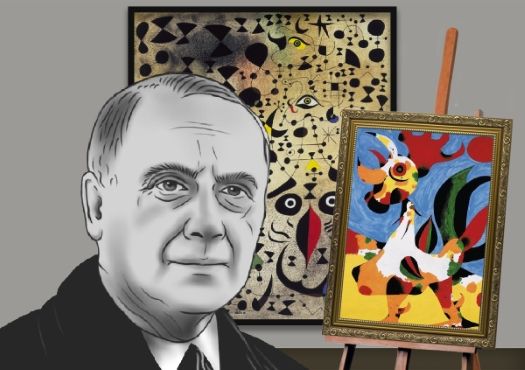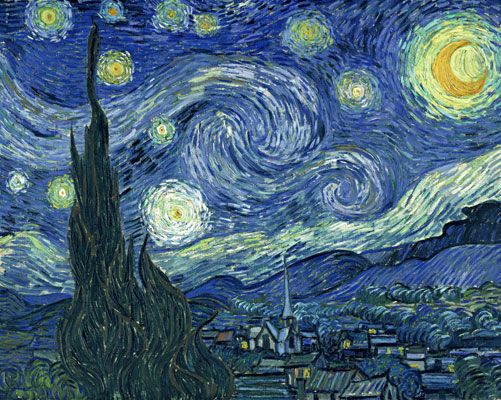Summary of Joan Miró
Persistent experimentation and a lifelong flirtation with non-objectivity stamped Joan Miró's magnificent mark on the art world. His canvas represented a sandbox for his subconscious mind, out from which sprang a vigorous lust for the childlike and a manifestation of his Catalan pride. His signature pictorial signs, biomorphic forms, geometric shapes, and abstracted and semi-abstracted objects helped inform a relentlessly original oeuvre in multiple media from ceramics and engravings to large bronze installations. His radically, inventive style was a critical contributor to the early-20th-century avant-garde's journey toward increasing and then complete abstraction. Although Miró has been associated with early Surrealism and has had an influence on Abstract Expressionists and Color Field painters, he remains one of modern art's greatest mavericks with a visual vocabulary unmistakably his own.
Accomplishments
- Via his own Surrealism-inspired exploration, Miró invented a new kind of pictorial space in which carefully rendered objects issuing strictly from the artist's imagination became juxtaposed with basic, recognizable forms. His use of interior emotion to drive abstract expression would become a great influence on the Abstract Expressionists.
- Even though he pared his forms to abstract schematics or pictorial signs and gestures Miró's art never settled into complete non-objectivity. Rather, he devoted his career to exploring various means by which to dismantle traditional precepts of representation.
- Miró balanced the kind of spontaneity and automatism encouraged by the Surrealists with meticulous planning and rendering to achieve finished works that, because of their precision, seemed plausibly representational despite their considerable level of abstraction.
- Miró often worked with a limited palette, yet the colors he used were bold and expressive. His chromatic explorations, which emphasized the potential of fields of unblended color to respond to one another, as well as his flat backgrounds with mild gradations of color, were valuable resources, providing inspiration for Color Field painters such as Helen Frankenthaler.
- Miró was a modern renegade who refused to limit himself to visual exploration in a single medium. While he explored certain themes such as that of Mother and Child repeatedly throughout his long career, he did so in a variety of media from painting and printmaking to sculpture and ceramics, often achieving surprising and disparate results.
The Life of Joan Miró
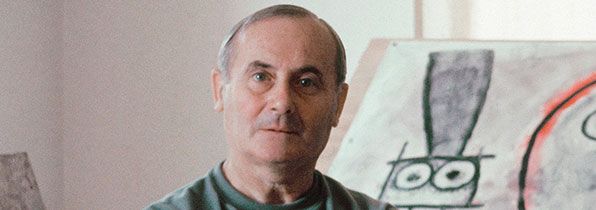
Though he lived a quiet life, rooted in Spain, Miró's was fiercely independent, at a 1978 exhibition he exclaimed, "I painted these paintings in a frenzy, with real violence so that people will know that I am alive, that I'm breathing, that I still have a few more places to go. I'm heading in new directions." He was 85.
Important Art by Joan Miró
The Farm
A dramatically tilted picture plane presents a view of the artist's masia or "family farm," thronging with animals, farm implements, plants, and evidence of human activity. Miró explained, "The Farm was a résumé of my entire life in the country. I wanted to put everything I loved about the country into that canvas - from a huge tree to a tiny snail." The intensity of vision and almost maniacal attention to detail gives the work the quality of an eidetic memory, reconfigured in a dream, and prefigures his later Surrealist work.
As art critic Laura Cummings wrote, "every entity is given its own autonomous space in the picture, separately praised but connected by rhyming shapes," due to the "quasi-cubist space, tilted upright; and presumably because Miró is celebrating the thriving upward growth of home."
The work illustrates important innovations signature to the artist as it includes various abstracted elements, like the black circle where the eucalyptus tree rises in the center, symbols like the two ladders, one with a goat standing on top, and the other with a rooster. Furthermore, as Cummings notes, in "his new way of painting... objects have a double life as letters - the E of a crate, the A of a ladder, the O of wheel, pail and sun - and everything is simultaneously inside the scene and written on its surface. The Farm is both picture and poem."
The artist considered this work among his most important, marking a turning point. While reflecting a number of influences, including Catalan folk art, a Romanesque sense of hierarchy where scale reflects importance, and a Cubist vocabulary, the work resisted settling into a style, exemplifying the artist's restless and iconoclastic approach.
After completing the work, Miró struggled to find a buyer in a Parisian modern art market that preferred Cubism. One dealer suggested cutting it into several smaller paintings for ease of sale. Fortunately, the artist had become friends with the writer Ernest Hemingway, then a struggling unknown, and, after hours of working the two would meet for boxing sessions to unwind. Hemingway was determined to buy The Farm and, after borrowing money and working as a grocery clerk, was able to purchase it and kept it throughout his life. As he wrote, "I would not trade it for any picture in the world. It has in it all that you feel about Spain when you are there and all that you feel when you are away and cannot go there."
Oil on canvas - National Gallery of Art, Washington, D.C.
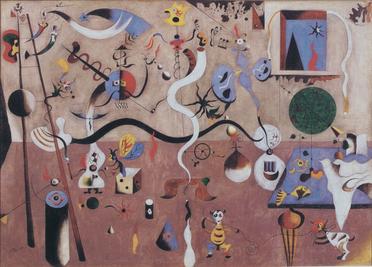
Harlequin's Carnival
This painting depicts a festive and crowded scene where quixotic biomorphs seem to be caught up in a lively celebration. Every form both evokes resemblances and refuses them, as at center left, the harlequin, identified by the black and white checks of the costume of the Italian commedia dell'arte's stock figure, has a body shaped like a distorted guitar. The cat, at lower right, stands up on its hind legs, as if dancing, its "arms" held out to the scene, while its red and yellow face turns to look at the viewer. A yellow and black fish lies on the table, an ear and an eye grow out of the ladder on the left, music notes appear on the wall, black and white snakelike tubes cross in the center, and many of the forms are connected by thin scrolling lines, as the black and yellow creature dancing in the lower center grasps a thread that extends to the cat's whiskers. The viewer is caught up in this imagined world, intrigued by the dissonance between identification and meaning.
An early example of the artist's turn toward Surrealism, this work also pioneered his use of biomorphic forms, as most of the objects evoke living organisms. He explained some of the painting's symbolic meaning, saying that the black triangle symbolized the Eiffel Tower and the ladder stood for both elevation and evasion. Yet the merging and melding forms overturn the certainties of the conscious world, including those of art, as the artist said, "I'm only interested in anonymous art, the kind that springs from the collective unconscious." Miró never wanted to settle into a particular artistic style and strove to overturn aesthetic hierarchies. In this work he created his own pictorial idiom. As art critic Laura Cummings wrote, "When Miró died in 1983, at the age of 90, he had long been cherished as the last of the modernist stars. His pictorial language was singular, instantly recognizable and - quite rightly - no longer perceived as some Catalan dialect of Surrealism."
Oil on canvas - Albright-Knox Art Gallery, Buffalo, New York
Dog Barking at the Moon
In a spare landscape that is both Surrealistic and humorously cartoonish, divided between rich chocolate earth and a black night sky, a whimsically distorted dog, depicted in bright colors, barks up at the moon above him. On the left, a ladder, depicted in white and yellow with red rungs, extends into the sky. The distortions of the moon and the dog, along with the improbability of the ladder, create a sense of play where everything both is and is not what it seems, while the white, red, and yellow, used for the four forms, creates some mysterious sense of connection between them.
As art critic Laura Cummings wrote, "On the ground, a multicoloured critter with something like paws and jaws barks at the moon with all the energy implicit in its tightly sprung form. The moon is not quite immune to this absurd display: it has a painted heart. But it also wears a satirical red nose." Yet the vast space, filled by the dark background, also evokes a sense of deep loneliness and mystery, as art critic Judith Flanders wrote, "At his best, in works like Dog Barking at the Moon, he created a mysteriously floating, unanchored world where his standard lexicon of symbols - here the ladder, symbolising not only individuality and escape, but also futility and an exit into the void of death - become potent."
In the period preceding this work, the artist had begun sometimes including words in his paintings, creating what he called "painting poems." The original sketch included the moon's response to the dog in Catalan, "You know, I don't give a damn." Though Miró left the text out of the painting, a feeling of implicit communication remains, created by the dog's insistence, its body lifting with its unheard voice, and by the moon, visually, seeming to turn away in rejection. As Cummings noted, the work famous "as a work of surrealism...has equally been interpreted a personal manifesto. Here is the young artist as a pup, trying to find his voice in the international avant-garde. The beautiful ladder must therefore be his art, by which he will ascend."
Oil on canvas - A. E. Gallatin Collection, Philadelphia Museum of Art, Philadelphia, Pennsylvania
Dutch Interior (I)
This painting is based on Hendrick Martensz Sorgh's Lute Player (1661), a Dutch Golden Age genre painting showing a domestic interior where a young man with a small dog at his feet serenades a young woman who seems unimpressed, as a cat looks out from under the table. Here, the young woman is left out and the lute player becomes a biomorphic shape with a red circular face surrounded by a large white circular collar, a curlicue swirl of lines for hair, as he plays the lute that diagonally intersects the center of the canvas. The white of the collar extends to the right in angles and curves, and resembles a kind of oversized leg painted with small ambiguous symbols, a dark pyramid for genitalia next to a sperm like shape, a black crescent shoe at the "foot." Miró's dog echoes the original but has a bone shaped body. As art critic Karen Rosenberg wrote, "presences become floating, Surrealist apparitions - unmoored and ambiguous but still mischievous," becoming "a giddy fantasia in green and orange, with the lute player as a kind of Pied Piper to various birds and beasts."
This work is the first in a series of three that the artist painted after visiting the Netherlands for the first time in 1928. The same year, following a very successful exhibition of his work in Paris, the artist said, "I understood the dangers of success and felt that, rather than dully exploiting it, I must launch into new ventures." When he subsequently went to Brussels for an opening of his friend Hans Arp's work, he took the opportunity to visit the leading Dutch museums where he wrote, he was "seduced by the ability of the Dutch painters to make dots as tiny as grains of dust visible and to concentrate attention on a tiny spark in the middle of obscurity." Taken particularly with Hendrick Sorgh's Lute Player (1666) and Jan Steen's Children Teaching a Cat to Dance (1660-1679), two notable genre paintings, he bought two postcard reproductions and returning to his family's farm near Barcelona began painting.
As Rosenberg wrote, "In bold, flat colors that rejected the naturalistic modeling and perspective of seventeenth-century Dutch painting, Miró greatly accentuated some elements of Sorgh's composition...while diminishing others." The three works became radical explorations of what art historians Panda de Haan and Ludo Van Halem called the artist's "mirómorphosis" and, after finishing them, Miró wrote, "When I finish a work, I see in it the starting point for another work. But nothing more than a starting point to go in a diametrically opposite direction."
Oil on canvas - The Museum of Modern Art, New York
The Beautiful Bird Revealing the Unknown to a Pair of Lovers
This painting uses a reduced palette to present many small blue, green, yellow, red, and predominantly black forms that resemble signs, globes, stars, and eyes that populate the opalescent, tawny background. While searching for the lovers and the bird, viewers are drawn further in by the plethora of lines that connect them, woven into a complex constellation against a night sky.
As art historian Laurie Edison noted, "Unlike stars, which exist physically in the sky, constellations exist only conceptually... we are the ones who conceptualize invisible lines between stars to connect them to each other, " and, as a result the work, like "the function of constellations," reveals "a shape that is a pure construct." That construct reveals as art critic Tim Adams wrote, "the most vibrant expression of Miró's inner universe," his deep sense of inner connection.
In 1939 with the outbreak of the war, Miró fled Paris with his family to Normandy. The small village was often in a state of blackout. He wrote, "I had always enjoyed looking out of the windows at night and seeing the sky and the stars and the moon, but now we weren't allowed to do this any more, so I painted the windows blue and I took my brushes and paint, and that was the beginning of the Constellations." This work is part of a series of 24 paintings on paper upon which Miró innovatived his own language of signs to help him cope with the difficult life circumstances. He said, "When I was painting the Constellations, I had the genuine feeling that I was working in secret, but it was a liberation for me in that I ceased thinking about the tragedy all around me."
Miró considered the series among his most important works, and they indeed became his most influential. His ability to bring forth illustrative form to his emotions laid a great foundation for the ensuing Abstract Expressionist movement. The series also inspired André Breton's series of prose poems Constellations (1958).
As the critic David Sylvester once said: "Miró's art may well have been the most far-reaching single influence the American Abstract Expressionists had. It is reflected in Pollock and Gorky, Gottlieb and Baziotes, Motherwell and Smith. And is there any influence other than his that has been common to both de Kooning and Rothko?"
Gouache, oil wash, and charcoal on paper - The Museum of Modern Art, New York
Bleu II
This monumental canvas, nearly 12 feet by 9 feet, part of a series of three, uses simple abstract shapes against a blue background, painted with uniform brushstrokes. A slightly diagonal red stroke adds dramatic contrast, emphasizing the infinite and vacant expanse, while a series of black, irregularly round shapes, evokes a private language of signs, energetically extending across the horizon.
Miró often used a blue field in his work, as he identified the color not only with the vast sky, but also with the world of dreams, as seen in his Photo: This Is the Color of My Dreams (1925). The intense blue dominates, capturing the artist's feeling as he wrote, "The spectacle of the sky overwhelms me. I'm overwhelmed when I see, in an immense sky, the crescent of the moon, or the sun. There, in my pictures, tiny forms in huge, empty spaces. Empty spaces, empty horizons, empty plains - everything which is bare has always greatly impressed me." His Bleu series was painted at a time when he was internationally famous and the enormous scale of the three canvases were a kind of artistic statement, a tour de force.
Miró's work influenced the Abstract Expressionists and, particularly, the Color Field painters, and some critics view this monumental series as reflecting those movements' subsequent influence upon him. But at the same time, the work also draws upon his lifelong preoccupations and ancient sources, as he said, "Little by little, I've reached the stage of using only a small number of forms and colors. It's not the first time that painting has been done with a very narrow range of colors. The frescoes of the tenth century are painted like this. For me, they are magnificent things."
Oil on canvas - Centre Georges Pompidou, Paris
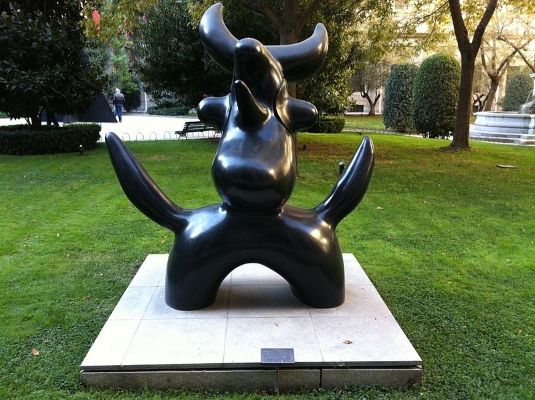
Pájaro lunar (Moonbird)
This sculpture depicts a hybrid creature, its face and horns lunar shaped, while its two arms resemble the arc of wings, but are devoid of plumage. Its squat horizontal torso with two limbs firmly planted has a primal power, as if drawing strength from the earth. The many hornlike shapes not only evoke crescent moons and birds, but the tradition of Spanish bullfighting. The work becomes a powerful totem, as art historian Carmen Fernández Aparicio wrote, "Miró brought together metaphorical mineral forms and ideas from the natural and cosmic world to create a strange, hybrid character, a sort of monster with a shining, polished surface."
Sculpture allowed Miró to embody his long-time preoccupations, as here, the moon, the bird, and the theme of Catalonia, fuse into one iconic and idiosyncratic three-dimensional form. Miró turned to sculpture in the 1940s, feeling as he said, "It is in sculpture that I will create a truly phantasmagoric world of living monsters; what I do in painting is more conventional." He molded the works by hand, as this work, created in 1946-49, shows in its soft contours and sensitive modeling. As a result, the work seems to have sprung out of the natural world, resembling an organic form that has taken shape in dark shining metal. In the 1960s, he enlarged the original model to make casts of the work, which can be found in museums and sculptural parks throughout the world.
Bronze - Museo Nacional Centro de Arte Reina Sofía, Madrid
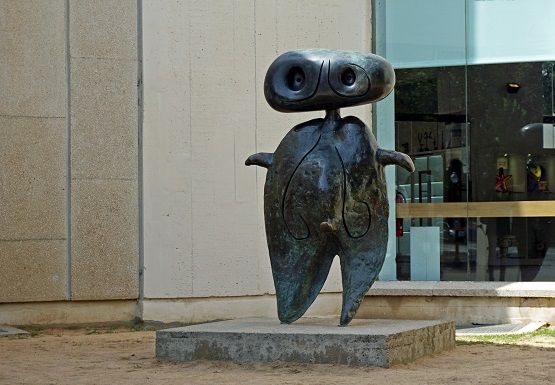
Personnage
This bronze sculpture depicts a figure, whose biomorphic shape evokes vegetable forms, flower petals, and marine-like flippers. The creature's head, elongated horizontally, has prominent sunken eyes, bordered with curvilinear incisions, that seem to stare out poignantly from a kind of cosmic space, evoking an encounter with the extraterrestrial. Yet the arms, legs, torso, neck, and genitalia also evoke the human, whimsically reconfigured to both intrigue and challenge the viewer. This personage, or notable character, from what the artist called his "truly phantasmagoric world of living monsters" evokes humanity's common condition as both organically formed from nature yet also alienated from it.
Miró was first known for creating these bizarre creatures through his "dream paintings," which were made in an automatic state, driven, as he said, by hallucinations due to hunger. He first explored this theme in paintings like Personage (1925), where a ghostly balloon-like figure hovered in an ethereal blue and undefined space. Evoking the psychological concept of the persona, or social mask, the artist said, "Wildness is the flip side to my character - I'm well aware. Naturally, when I'm with people, I can't be brutal in speaking and I put on, one might say, a kind of mask." Yet in his art, a kind of wild play allowed him to mock his own personages, "Mocking man, that puppet which cannot be taken seriously." Nonetheless, the figure here, evolved into sculptural form, has a totemic dignity, evoking a being of note, invented but otherworldly, as it transforms the space of its display into a space of improbable encounter.
Miró's personages influenced later artists including Robert Motherwell and Louise Bourgeois.
Bronze - Fundació Joan Miró, Barcelona, Spain
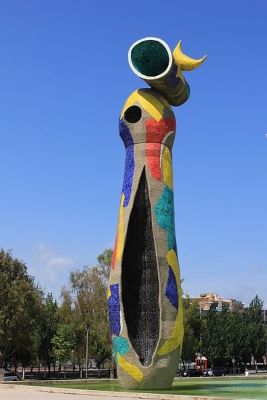
Woman and Bird
This monumental sculpture, standing 66 feet tall, depicts a woman, her massive form painted in bright primary colors, wearing a tubular "hat" topped with a yellow bird that evokes a crescent moon. Yet the work is ambiguous, its phallic shape informing the viewer's initial impression. As a result, the viewer has to pause and interpret the work, thus, entering the artist's interior iconography, where woman symbolized the earth, the moon symbolized the heavens, and birds were meditators connecting the two realms. Due to its massive size, it becomes a kind of talisman for Miró, a public statement embodying the motifs he developed in his Constellations series (1939-41) and evolved throughout his career.
The sculpture, built of colorful, broken ceramic tiles, was one of the first major public art initiatives in Barcelona, following the re-establishment of democracy, and is considered Miró's last great work. The use of mosaic and irregular contours were a kind of homage to Barcelona's great architect Antonio Gaudi, with whom Miró had studied. Evoking the colossal statues that stood at the entrance of ancient Greek cities, marking sacred spaces, the work rises out of a large reflecting pool in the Parc de Joan Miró, which is also populated with 30 other sculptures by the artist.
Concrete and tiles - Parc de Joan Miró, Barcelona, Spain
Biography of Joan Miró
Childhood
Joan Miró was born in Spain in 1893 to a family of craftsmen. His father Miguel was a watchmaker and goldsmith, while his mother was the daughter of a cabinetmaker. Perhaps in keeping with his family's artistic trade, Miró exhibited a strong love of drawing at an early age; not particularly inclined toward academics, he said he was "a very poor student...quiet, rather taciturn, and a dreamer."
In 1907 when he was fourteen, Miró began studying landscape and decorative art at the School of Industrial and Fine Arts (the Llotja) in Barcelona. At the same time, at the behest of his parents who wanted him to pursue a more practical career, he attended the School of Commerce. He began working as a clerk, and because of the constant demands of his studies, he experienced what has been characterized as a nervous breakdown, followed by a severe case of typhoid fever. His family bought Montroig, a farm in the countryside outside of Barcelona, as a place where Miró could recover, and as he convalesced, he devoted himself fully to making art and abandoned his commercial pursuits.
Early Training
In 1912, Miró enrolled in an art academy in Barcelona where he learned about modern art movements and contemporary Catalan poets. Poetry was to have a lifelong influence on him, as he said later, "I make no distinction between painting and poetry," seeing his work as implicitly metaphoric, evoking resemblance to objective reality, while remaining outside of it. As part of his studies, his teacher Francisco Galí had the young artist draw by touch, sometimes while blindfolded, to encourage a spatial understanding of objects while relying upon intuition. Miró also associated with the Cercle Artístic de Sant Lluc, an artistic group that included renowned architect Antoni Gaudí among its members. Between 1912 and 1920, Miró painted still-lifes, portraits, nudes, and landscapes, in a style, dubbed Catalan Fauvism by some scholars. Influenced by Vincent van Gogh, Paul Cézanne, and the bold, bright colors of the French Fauve painters, he also drew upon his Catalan roots, calling himself "an international Catalan."
Mature Period
Miró's first solo show in Barcelona in 1918 was a complete disaster, his works ridiculed by both critics and the public, with not a single work sold. Utterly disappointed and seeking a more invigorating and receptive artistic world, he went to Paris in 1920, where he met a number of artists, including Max Jacob, Pablo Picasso, André Masson, and Tristan Tzara. However, it wasn't until three and a half months later when he went home to the Montroig farm that he was able to paint, saying, "I immediately burst into painting the way children burst into tears." For the following decade, to maintain the balance between his Catalan inspiration and the Parisian art world, he subsequently began living in Paris for part of the year, while returning to Montroig every summer, as he said, "Paris and the countryside until I die." Due to financial hardship, his life in Paris was difficult at first. Later describing those lean, early years, he quipped, "How did I think up my drawings and my ideas for painting? Well, I'd come home to my Paris studio in Rue Blomet at night, I'd go to bed, and sometimes I hadn't had any supper." Yet, it seems that physical deprivation enlivened the young Miró's imagination. "I saw things," he explained, "and I jotted them down in a notebook. I saw shapes on the ceiling."
He had his first solo show in Paris in 1921 and exhibited at the Salon d'Automne in 1922, while associating with many of the leading Dada and Surrealist artists. He became friends with the Surrealist writer and leader, André Breton, forming a relationship that lasted for many years. The Surrealists were most active in Paris during the 1920s, having formally joined forces in 1924 with the publication of their Surrealist Manifesto. Their members, led by Breton, promoted "pure psychic automatism," a concept for which Miró felt an affinity from his own history of unconscious drawing through touch and intuition. He participated in the first Surrealist exhibition in 1925, though, nonetheless, as art historian Stanley Meisler noted, he "steadfastly refused to sign any Surrealist manifesto, especially the ones extolling 'psychic automatism.' He simply refused to believe that any painting could come full-blown out of a dream." His increasingly biomorphic, enigmatic, and innovative art, as seen in the Harlequin's Carnival (1924-25), a work he said he painted in a "hallucination of hunger," was also carefully planned, first composed on a grid background. Simultaneously, he also explored near abstract treatments, as he simplified his biomorphic forms to schematic shapes, pictorial signs, and visual gestures, as seen in his Painting (1927), where three ambiguous shapes and schematic lines are depicted against an empty blue background.
Miró married Pilar Juncosa in 1929, and their only child Dolores was born in 1931. As his art began to be exhibited and sold in both France and the United States, his career began to flourish, though any economic stability was cut short by the effects of the global depression. In 1932, no longer able to support his family in Paris, they moved to Barcelona. Years of disruption followed, as in 1936 while visiting Paris he was trapped with his family, unable to return to Spain where the civil war had erupted. In 1939 he fled to Normandy as the German invasion threatened and in 1941 to Mallorca, where he said, "I was very pessimistic. I felt that everything was lost." He turned to painting small works on paper, which he titled Constellations (1939-41), of which he said, "When I was painting the Constellations I had the genuine feeling that I was working in secret. But it was a liberation for me...I ceased thinking about all the tragedy around me."
Ironically, while he was hiding in Mallorca, using his wife's last name to escape the attention of Franco's government, Miró was given his first retrospective at New York City's Museum of Modern Art to great acclaim. When, immediately following the end of the war, Constellations was also shown in New York, his renown continued to grow in America, prompting a large-scale mural commission in Cincinnati in 1947. Miró's simplified forms and his life-long impulse toward experimentation inspired the generation of American Abstract Expressionists whose emphasis on non-representational art signaled a major shift in artistic production in the both the U.S. and in Europe. Yet, despite the acclaim for his paintings, he continued to explore new media, turning to ceramics, as he collaborated with Joseph Llorens Artigas, and to sculpture in the mid-1940s.
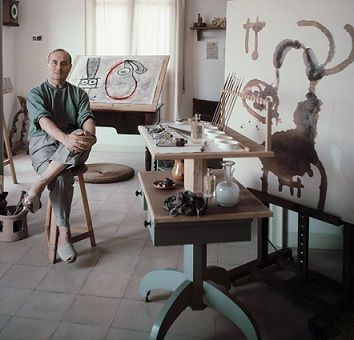
In the 1950s, Miró again began dividing his time between Spain and France. A large exhibition of his works was held at the Gallerie Maeght in Paris and subsequently at the Pierre Matisse Gallery in New York in 1953. However, from 1954-58 he worked almost exclusively on printmaking and ceramics, including two ceramic wall murals for the UNESCO building in Paris. In 1959, he, along with Salvador Dalí, Enrique Tabara, and Eugenio Granell participated in Homage to Surrealism, an exhibition in Spain organized by André Breton. The 1960s were a prolific and adventurous time for Miró as he painted the large abstract triptych Bleu (1961) and worked intensely in sculpture, in some instances revisiting and reinterpreting some of his older works. While he never altered the essence of his style, his later work is recognized as more mature, distilled, and refined in terms of form.
Late Period and Death
As Miró aged, he continued to receive many accolades and public commissions. He continued to head in new directions, saying, "It's the young people who interest me, and not the old dodos. If I go on working, it's for the year 2000, and for the people of tomorrow." In 1974, he was commissioned to create a tapestry for New York's World Trade Center, demonstrating his achievements as an internationally renowned artist as well as his place in popular culture. He received an honorary degree from the University of Barcelona in 1979. Miró died at his home in 1983, a year after completing Woman and Bird, a grand public sculpture for the city of Barcelona. The work was, in a sense, the culmination of a prolific career, one so profoundly integral to the development of modern art.
The Legacy of Joan Miró
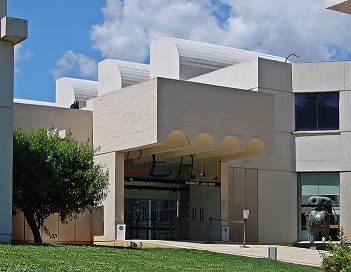
Miró once famously stated, "I want to assassinate painting." Along with other Dada and Surrealist artists like Jean Arp and Yves Tanguy, he explored the possibility of creating an entirely new visual vocabulary for art that could exist outside of the objective world, while not divorced from it. His unique artistic idiom often used biomorphic forms that remained within the bounds of objectivity, while simultaneously being forms of pure invention. Expressive and imbued with meaning through their juxtaposition with other forms and the artist's use of color, they became increasingly abstract pictorial signs. His explorations of all media and innovative techniques gave his work an edge - simultaneously, new, yet instantly recognizable as Miró.
What art critic Ryan Steadman called Miró's "personal form of abstraction" was a defining influence on his longtime close friend Alexander Calder and on the Abstract Expressionists Jackson Pollock, Robert Motherwell, Arshile Gorky, and William Baziotes, as well as the Color Field painters Mark Rothko and Barnett Newman. Helen Frankenthaler also credited Miró's influence upon the development of her Post-Painterly Abstraction style. More recently, his work has influenced the designers Paul Rand, Lucienne Day, and Julian Hatton, as well as contemporary artists Josh Smith and Chris Martin.
To this day, Miró's freewheeling artistic expression continues to be a generating spark for evolving artists and art movements.
Influences and Connections

Useful Resources on Joan Miró
- Miró (Taschen 25th Anniversary)Our PickBy Walter Erben, Hajo Duchting
- Joan MiróBy Rosa Maria Malet
- Joan Miró: Painting and Anti-Painting 1927-1937By Jim Coddington, Robert Lubar, Anne Umland, Joan Miró
- Joan Miró 1917-1934: I'm Going To Smash Their GuitarBy Agnes de la Beaumelle
- MiróBy Jacques Dupin
